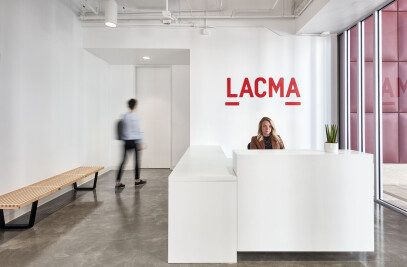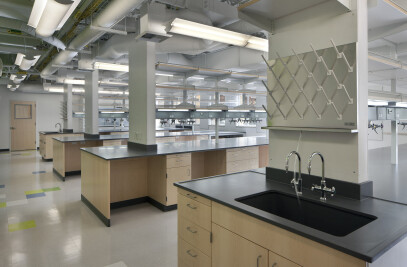CO Architects conceptualized a functional and flexible vertical garden hospital set within a campus configuration. The greenfield site—part of a 186-acre business park currently under development—is bounded by residential property to the west, light industrial development to the north, Citracado Parkway and a Sempra power plant to the east, and future business park development
to the south. The plan positions the hospital at the north end of the site, where there is the greatest width to accommodate necessary access points and circulation.
The signature patient tower building—with its gently curving form—figuratively opens its arms to welcome patients. A vertical garden at the center of the south façade overlooks the extensive landscaped roof and garden terraces above the two-story diagnostic and treatment wing. The conservatory element is repeated at the east and west ends to reinforce the garden hospital concept. Site planning, landscaping, non-institutional architectural expression, and materials selection are all strongly influenced by the desire to merge nature and building, with each aspect informing the other to create a unified whole.
Flexibility
CO Architects created an innovative plan that fulfills the requirements for flexibility, patient safety, quality care, and a healthful environment.
The flexible plan of the Diagnostic and Treatment wing accommodates the changes to equipment, technology, and treatment that are expected through the lifetime of the hospital. For example, an Integrated Interventional Platform was developed on the Second Level where a co-location of Surgical and Interventional Radiology procedure rooms creates an interdisciplinary approach to procedural medicine. This seamless integration of various types of procedures through a modular planning approach will increase flexibility (ability to change use of the rooms over time), reduce staffing requirements (consolidation of service eliminates duplication of support personnel), and will promote interaction among the specialists. The systems infrastructure elements of long-span structural bays, high floor-to-floor heights with interstitial capacity, and open “loft space” contribute to the flexible platform.
The design of the nursing units located on Levels 4 through 11 represents a non-traditional approach to the programming and design of patient-care facilities. Driven by the research that stemmed from Evidenced Based Design planning principles, the units enable an Acuity Adaptable Patient Care model, which accounts for the provision of patient rooms and units to be commonly sized to accommodate the full spectrum of care. This will be the first attempt to install such a model in California, and, if fully realized, will minimize or eliminate the need to transfer patients to other rooms/units during hospital stays. This, in turn, will potentially provide better continuity of care and care teams, reduce medical errors, reduce treatment delays, improve operational efficiencies, and improve patient and staff satisfaction.
Decentralized staff work areas and supplies (adjacent to the patient rooms) will reduce the amount of staff time spent searching for supplies, and thus will increase time for patient supervision and direct care.
All of the 360 beds are in private rooms designed with sufficient space for in-room procedures, including accommodating “rooming-in” of family members. Additionally, patients are given individual control of as many environmental elements as possible, including temperature, lighting, and privacy.
Sustainability:
It is the mission of PH and the impulse of CO Architects to honor the relationship of the individual to the environment and maintain the hallmarks of sustainable building. Healthy indoor air quality, a soothing and healing environment, and the materials and methods employed all reflect the commitment of the client and architect. Thus, PMC embodies two main directives of sustainable healthcare design: 1) Create an environment that promotes health and healing; 2) Reduce the impact on the natural environment in construction and operations. Because of efficient mechanical equipment, lighting systems, and envelope design, the building will perform significantly better than a typical hospital would in a similar climate.
PMC is designed as a pilot project using the Green Guide for Healthcare (GGHC), a rating system specifically designed for healthcare projects. Under the auspices of the Center for Maximum Potential Building Systems and Health Care Without Harm, and following the LEED model, the guide provides the healthcare sector with a voluntary, self-certifying toolkit of best practices that designers can use to guide and evaluate their progress toward high-performance healing environments.
The surgical wing’s green roof, planted with drought-tolerant succulents, provides a connection to nature for patients in the nursing tower and is integrated into the building’s structural and mechanical performance. The roof contributes to energy efficiency by reducing ground reflectance and solar heat gain in the tower’s interiors and is integrated into the storm-water management system. Outdoor courts cut into the two-story wing, bringing natural light to the functionally determined deep floor plates.
Conservatory gardens are located at the center and at both ends of each patient floor. In addition to bringing landscaped gardens to all the inhabitants of the vertical building, they also provide an additional layer of solar protection for the fully glazed adjoining public spaces.
The patient tower is oriented to minimize east/west exposures in its arid, inland valley context, and is designed to take maximum advantage of daylight. A perforated metal screen system on the south façade provides shade to patient rooms while allowing maximum views and natural light. The screen unifies the building’s projecting elements and consists of two components: a second skin that sits parallel to the curtain-wall enclosure, and horizontal louvers that address summer sun angles. Where the screens extend to the garden terraces, they serve as wind protection for the high-rise outdoor spaces.
Other energy-efficient measures at PMC include vigorous energy management systems, capture and reuse of waste heat, efficient lighting strategies, daylight controls, variable air volume handling, building commissioning, and the careful selection of energy-saving medical equipment.
Palomar Medical Center (PMC) consists of:
Lower Level: Loading Dock, Material Management, Central Sterile, Morgue, Housekeeping/EVS, Food Service, Laboratory
First Level: Emergency Department, Imaging Department, Outpatient Diagnostic Center, Respiratory Therapy, Public Lobbies, Conference Center
Second Level: Surgical Services, Interventional Cardiology and Radiology, Clean Procedures, Perioperative Care Unit, Pre-admission Testing, Meditation Room, Public Learning Center, Pharmacy
Third Level: Public Café, Outdoor Terraces, Mechanical Systems
Fourth through Eleventh Levels: Patient Care Tower—Acuity Reassignable Units and Medical/Surgical Units


































